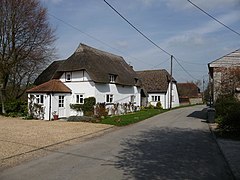Nether Wallop is a village and civil parish in the Test Valley district of Hampshire, England, 3+1⁄2 miles (6 kilometres) northwest of Stockbridge, and seven miles (eleven kilometres) southwest of Andover.
| Nether Wallop | |
|---|---|
 Thatched cottage | |
Location within Hampshire | |
| Population | 876 (2011 Census)[1] |
| OS grid reference | SU2996536570 |
| Civil parish |
|
| District | |
| Shire county | |
| Region | |
| Country | England |
| Sovereign state | United Kingdom |
| Post town | STOCKBRIDGE |
| Postcode district | SO20 |
| Dialling code | 01264 |
| Police | Hampshire and Isle of Wight |
| Fire | Hampshire and Isle of Wight |
| Ambulance | South Central |
| UK Parliament | |
| Website | The Wallops |
Nether Wallop is the easternmost of the three villages collectively known as The Wallops, the other two being Over Wallop and Middle Wallop. The name "Wallop" derives from the Old English words waella and hop, which taken together roughly mean "the valley of springing water".
The village was the site of the Battle of Guoloph that took place around 440 CE. The element "Wallop" is first attested in the Domesday Book of 1086 as "Wallope", while Nether Wallop is first attested as "Wollop inferior" c. 1270 in Episcopal Registers.[2]
Nether Wallop contains many old thatched cottages, and has been featured in books and TV programmes as one of the prettiest villages in England.[3] In particular, Dane Cottage in Five Bells Lane was used as Miss Marple's home in the village of St. Mary Mead for the BBC TV adaptations of the Agatha Christie novels. The house and many of the surrounding lanes within the village were used as the setting and are commonly seen throughout many of the Miss Marple films.
Sir Richard Reade (1511–1575), Lord Chancellor of Ireland, was a native of Nether Wallop, where his family were Lords of the Manor for several generations.
The conductor Leopold Stokowski died at his home in Nether Wallop on 13 September 1977.

The church of St Andrew is partly Anglo-Saxon, and fragments of frescoes dating to that period have been discovered.[4]
Further reading
- Richard Sawyer Saint Andrew's Church, Nether Wallop, Hampshire: Its Historical Development, Wall Paintings and Monuments pub. Saint Andrew's Church, Nether Wallop, Parochial Church Council, 1985
References
External links
Wikiwand in your browser!
Seamless Wikipedia browsing. On steroids.
Every time you click a link to Wikipedia, Wiktionary or Wikiquote in your browser's search results, it will show the modern Wikiwand interface.
Wikiwand extension is a five stars, simple, with minimum permission required to keep your browsing private, safe and transparent.

